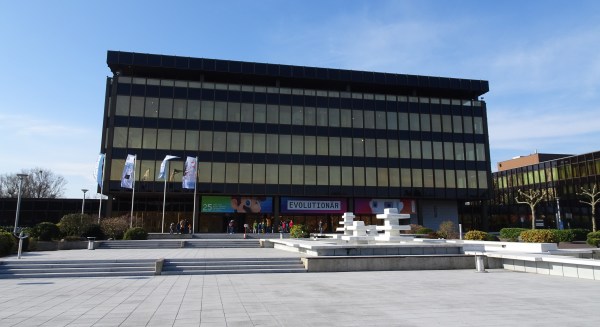It’s that time of year again — the 2022 Hackaday Prize has officially launched, and we’re excited to see what it turns out. This year’s theme is “Sustainability, Resilience, and Circularity,” and just in time, too; if the last couple of years has taught us anything, it’s that we’ve got a lot of failure points built into the systems that run our world. As broken as things are, it’s tempting to just curl up in a ball and pretend everything’s fine, but that’s not how hackers respond to adversity. We need to control what we can control, and there’s plenty of work to be done. From sustainable energy ideas to ways to reduce the amount of stuff we throw away, from breathing new life into old equipment to building communities that can take care of themselves, there’s plenty of work to be done. So get over to the Hackaday Prize page, check out the launch summit video if you need some inspiration, and get hacking. And hurry up — things are only going to get better if people like us make it happen.
Hackaday Columns4582 Articles
This excellent content from the Hackaday writing crew highlights recurring topics and popular series like Linux-Fu, 3D-Printering, Hackaday Links, This Week in Security, Inputs of Interest, Profiles in Science, Retrotechtacular, Ask Hackaday, Teardowns, Reviews, and many more.
Retrotechtacular: The Transatlantic Radiotelephone System Of The 1930s
With the web of undersea cables lacing the continents together now, it’s hard to imagine that it wasn’t until 1956 that the first transatlantic telephone cable was laid. Sure, there were telegraph cables under the Atlantic starting as early as the late 1800s, but getting your voice across the ocean on copper was a long time coming. So what was the discerning 1930s gentleman of business to do when only a voice call would do? He’d have used a radiotelephone, probably at an outrageous expense, which as this video on the receiving end of the New York to London radio connection shows, was probably entirely justified.
The video details the shortwave radiotelephone system that linked New York and London in the 1930s. It starts with a brief but thorough explanation of ionospheric refraction, and how that atmospheric phenomenon makes it possible to communicate over vast distances. It also offers a great explanation on the problems inherent with radio connections, like multipath interference and the dependency on the solar cycle for usable skip. To overcome these issues, the Cooling Radio Station was built, and its construction is the main thrust of the video.
Continue reading “Retrotechtacular: The Transatlantic Radiotelephone System Of The 1930s”
Hackaday Podcast 162: Hackaday Prize Is On, Thermal Printers Are So Hot These Days, Cloud Chambers Are Super Cool, And Batteries Must Be Replaceable
Join Hackaday Editor-in-Chief Elliot Williams and Managing Editor Tom Nardi for your weekly review of the best projects, hacks, and bits of news that we can cram into 45 minutes or so. We’ll look at the latest developments in DIY air-powered engines, discuss the whimsical combination of GitHub’s API and a cheap thermal printer, and marvel at impressive pieces of homebrew biology equipment. We’ve also got an exceptionally polished folding cyberdeck, a bevy of high-tech cloud chambers, and some soda bottles that are more than meets the eye. Finally we’ll go over the pros and cons of today’s super-smart cameras, and speculate wildly about what a new EU law means for our battery powered gadgets.
Take a look at the links below if you want to follow along, and as always, tell us what you think about this episode in the comments!
Direct download, and listen whenever you like.
This Week In Security: More State-Sponsored Activity, Spring4Shell
[Editor’s note: There is a second, fake iteration of this column out today. This is obviously the real column.]
An alert from CISA, combined with an unsealed pair of indictments, sheds some new light on how Russian hackers pursue high-value targets. The key malware here is Triton, essentially a rootkit designed for the Tricon safety systems, widely deployed at refineries and other infrastructure facilities. One of the early deployments of this was to a Saudi oil plant in 2017. This deployment seems to have been botched, as it caused malfunctions and shut the plant down for about a week.
The new information is confirmation that the same operators, out of the “Central Scientific Research Institute of Chemistry and Mechanics”, attempted to target US facilities with the same campaign. The Wired coverage initially struck me as odd, as it detailed how these Russian attackers researched US refineries, looking for the most promising targets. How exactly did US intelligence agencies know about the research habits of agents in Russia? The details of the indictment has the answer: They were researching US refineries by downloading papers from the US Department of Energy. As the IP addresses of this Russian research group is known and tracked, it was easy enough for US agencies to make the connection.
Continue reading “This Week In Security: More State-Sponsored Activity, Spring4Shell”
This WeeΚ In Security: Hackerman, Twitter’s Best, And Signs To Watch Out For
[Editor’s note: There is a second, fake iteration of this column out today. This is obviously the real column.]
First off, there’s an amazing video tutorial from [Hackerman], embedded below the break. It’s a beginners guide to temporal displacement through GPU accelerated, cellular-connected partition board. The central flaw that makes this possible is a segmentation violation, accessible through a mode 6 cursor address reset. Watch out, though, because many mainframes actually have a core terminal capable of shutting such an attempt out of the grid altogether.
It’s a great guide, and definitely worth a watch if temporal security tickles your fancy. Watch out, though, because everyday objects can apparently act as bridges, infecting even users with temporal effects.
Continue reading “This WeeΚ In Security: Hackerman, Twitter’s Best, And Signs To Watch Out For”
REMOTICON 2021 // Hal Rodriguez And Sahrye Cohen Combine Couture And Circuitry
[Hal Rodriguez] and [Sahrye Cohen] of Amped Atelier focus on creating interactive wearable garments with some fairly high standards. Every garment must be pretty, and has to either be controllable by the wearer, through a set of sensors, or even by the audience via Bluetooth. Among their past creations are a dress with color sensors and 3D-printed scales on the front that change color, and a flowing pantsuit designed for a dancer using an accelerometer to make light patterns based on her movements.
Conductive Melody — a wearable musical instrument that is the focus of [Sahrye] and [Hal]’s Remoticon 2021 talk — was created for a presentation at Beakerhead Festival, a multi-day STEAM-based gathering in Calgary. [Sahrye] and [Hal] truly joined forces for this one, because [Sahrye] is all about electronics and costuming, and [Hal] is into synths and electronic music. You can see the demo in the video after the break.
The dress’s form is inspired by classical instruments and the types of clothing that they in turn inspired, such as long, generous sleeves for harp players and pianists. So [Hal] and [Sahrye] dreamed up a dress with a single large playable sleeve that hangs down from the mid- and upper arm. The sleeve is covered with laser-cut conductive fabric curlicues that look like a baroque interpretation of harp strings. Play a note by touching one of these traces, and the lights on the front of the dress will move in sync with the music.
 [Sahrye] started the dress portion of Conductive Melody with a sketch of the garment’s broad strokes, then painted a more final drawing with lots of detail. Then she made a muslin, which is kind of the breadboard version of a project in garment-making where thin cotton fabric is used to help visualize the end result. Once satisfied with the fit, [Sahrye] then made the final dress out of good fabric. And we mean really good fabric — silk, in this case. Because as [Sahrye] says, if you’re going to make a one-off, why not make as nicely as possible? We can totally get behind that.
[Sahrye] started the dress portion of Conductive Melody with a sketch of the garment’s broad strokes, then painted a more final drawing with lots of detail. Then she made a muslin, which is kind of the breadboard version of a project in garment-making where thin cotton fabric is used to help visualize the end result. Once satisfied with the fit, [Sahrye] then made the final dress out of good fabric. And we mean really good fabric — silk, in this case. Because as [Sahrye] says, if you’re going to make a one-off, why not make as nicely as possible? We can totally get behind that.
 [Sahrye] says she is always thinking about how a wearable will be worn, and how it will be washed or otherwise cared for. That sequined and semi-sheer section of the bodice hides the LEDs and their wiring quite well, while still being comfortable for the wearer.
[Sahrye] says she is always thinking about how a wearable will be worn, and how it will be washed or otherwise cared for. That sequined and semi-sheer section of the bodice hides the LEDs and their wiring quite well, while still being comfortable for the wearer.
Inside the sleeve is an MPRP121 capacitive touch sensor and an Arduino that controls the LEDs and sends the signals to a Raspberry Pi hidden among the ruffles in the back of the dress.
The Pi is running Piano Genie, which can turn eight inputs into an 88-key piano in real time. When no one is playing the sleeve, the lights have a standby mode of mellow yellows and whites that fade in and out slowly compared to the more upbeat rainbow of musical mode.
We love to see wearable projects — especially such fancy creations! — but we know how finicky they can be. Among the lessons learned by [Sahrye] and [Hal]: don’t make your conductive fabric traces too thin, and silver conductive materials may tarnish irreparably. We just hope they didn’t have to waste too much conductive fabric or that nice blue silk to find this out.
Continue reading “REMOTICON 2021 // Hal Rodriguez And Sahrye Cohen Combine Couture And Circuitry”
Visit The World’s Largest Computer Museum: The Heinz Nixdorf
Most stories in the history of computing took place in one of a small number of places. The wartime code-breaking effort in Bletchley Park led to Colossus, the first programmable electronic computer. Various university campuses in Britain and the US were home to first-generation computers like ENIAC, EDVAC and the Manchester Baby in the late 1940s. Silicon Valley then stole the limelight with the home computer revolution in the 1970s. Naturally, all of these places have their museums celebrating their local achievements, but the world’s largest computer museum is not found in Silicon Valley or on the campus of a famous university. Instead, you have to travel to a small German town called Paderborn, which houses the Heinz Nixdorf Museumsforum, or HNF.
Heinz Nixdorf might not be a household name in America like Jack Tramiel or Steve Jobs, but he was one of Europe’s great computer pioneers. Starting with vacuum tube based machines in 1952, Nixdorf gradually expanded his company into one of the largest computer manufacturers of the 1970s. His products were especially popular among large businesses in the financial sector, such as banks and insurance companies. By the late 1980s however, sales went downhill and the company was eventually acquired by Siemens. Today, the Nixdorf name lives on as part of Diebold-Nixdorf, a major producer of ATMs and checkout machines, reflecting the original company’s focus on the financial industry.
The museum’s roots lie in Heinz Nixdorf’s personal collection of typewriters and other office equipment. Although he already envisioned starting a museum dedicated to computing, his sudden death in 1986 put a stop to that. A few of his employees kept the plan alive however, and in 1996 the HNF was opened in Paderborn. Today the museum is run by a non-profit foundation that aims to provide education in information and communication technology to a wide audience.
The collection is housed in the former worldwide headquarters of Nixdorf Computer AG, a rather imposing 1970s office building covered in gold-tinted windows. Inside,]] you’re reminded of its former life as an office building through its compact layout and low ceilings. It does give the museum a bit of a cosy feel, unlike, say, the cavernous halls of London’s Science Museum, but don’t let this fool you: at 6,000 m2, the main exhibition area is about twice as large as that of Silicon Valley’s Computer History Museum. Continue reading “Visit The World’s Largest Computer Museum: The Heinz Nixdorf”















